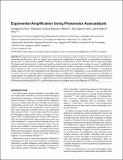Exponential Amplification Using Photoredox Autocatalysis
Author(s)
Kim, Seunghyeon; Martínez Dibildox, Alejandra; Aguirre-Soto, Alan; Sikes Johnson, Hadley
DownloadAccepted version (3.241Mb)
Open Access Policy
Open Access Policy
Creative Commons Attribution-Noncommercial-Share Alike
Terms of use
Metadata
Show full item recordAbstract
Exponential molecular amplification such as the polymerase chain reaction is a powerful tool that allows ultrasensitive biodetection. Here, we report a new exponential amplification strategy based on photoredox autocatalysis, where eosin Y, a photocatalyst, amplifies itself by activating a nonfluorescent eosin Y derivative (EYH³⁻) under green light. The deactivated photocatalyst is stable and rapidly activated under low-intensity light, making the eosin Y amplification suitable for resource-limited settings. Through steady-state kinetic studies and reaction modeling, we found that EYH³⁻ is either oxidized to eosin Y via one-electron oxidation by triplet eosin Y and subsequent 1e⁻/H⁺ transfer, or activated by singlet oxygen with the risk of degradation. By reducing the rate of the EYH³⁻ degradation, we successfully improved EYH³⁻-to-eosin Y recovery, achieving efficient autocatalytic eosin Y amplification. Additionally, to demonstrate its flexibility in output signals, we coupled the eosin Y amplification with photoinduced chromogenic polymerization, enabling sensitive visual detection of analytes. Finally, we applied the exponential amplification methods in developing bioassays for detection of biomarkers including SARS-CoV-2 nucleocapsid protein, an antigen used in the diagnosis of COVID-19.
Date issued
2021-07Department
Massachusetts Institute of Technology. Department of Chemical EngineeringJournal
Journal of the American Chemical Society
Publisher
American Chemical Society (ACS)
Citation
Kim, Seunghyeon et al. "Exponential Amplification Using Photoredox Autocatalysis." Journal of the American Chemical Society 143, 30 (July 2021): 11544–11553. © 2021 American Chemical Society
Version: Author's final manuscript
ISSN
0002-7863
1520-5126